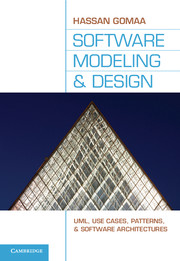Book contents
- Frontmatter
- Contents
- Preface
- Annotated Table of Contents
- Acknowledgments
- PART I Overview
- 1 Introduction
- 2 Overview of the UML Notation
- 3 Software Life Cycle Models and Processes
- 4 Software Design and Architecture Concepts
- 5 Overview of Software Modeling and Design Method
- PART II Software Modeling
- PART III Architectural Design
- PART IV Case Studies
- Appendix A Catalog of Software Architectural Patterns
- Appendix B Teaching Considerations
- Glossary
- Answers to Exercises
- Bibliography
- Index
4 - Software Design and Architecture Concepts
from PART I - Overview
Published online by Cambridge University Press: 05 June 2012
- Frontmatter
- Contents
- Preface
- Annotated Table of Contents
- Acknowledgments
- PART I Overview
- 1 Introduction
- 2 Overview of the UML Notation
- 3 Software Life Cycle Models and Processes
- 4 Software Design and Architecture Concepts
- 5 Overview of Software Modeling and Design Method
- PART II Software Modeling
- PART III Architectural Design
- PART IV Case Studies
- Appendix A Catalog of Software Architectural Patterns
- Appendix B Teaching Considerations
- Glossary
- Answers to Exercises
- Bibliography
- Index
Summary
This chapter describes key software design concepts that have shown their value over the years for the design of software architectures. First, object-oriented concepts are introduced, and objects and classes are described. Then there is a discussion of the role of information hiding in object-oriented design and an introduction to the concept of inheritance. Next, the concurrent processing concept and the concept of concurrent objects in concurrent applications are introduced. This is followed by an overview of software design patterns, software architecture, and the main characteristics of component-based systems. Finally, the concept of software quality attributes is discussed. Examples in this chapter are described in UML. An overview of the UML notation is given in Chapter 2.
Section 4.1 provides an overview of object-oriented concepts. Section 4.2 describes information hiding. Section 4.3 describes inheritance and generalization/ specialization relationships. Section 4.4 provides an overview of concurrent processing. Section 4.5 gives an overview of software design patterns, with the actual patterns described in subsequent chapters. Section 4.6 provides an overview of software architecture and the main characteristics of component-based systems. Finally, Section 4.7 gives an introduction to software quality attributes.
OBJECT-ORIENTED CONCEPTS
The term object-oriented was first introduced in connection to object-oriented programming and Smalltalk, although the object-oriented concepts of information hiding and inheritance have earlier origins. Information hiding and its use in software design date back to Parnas (1972), who advocated using information hiding as a way to design modules that were more self-contained and, hence, could be changed with little or no impact on other modules.
- Type
- Chapter
- Information
- Software Modeling and DesignUML, Use Cases, Patterns, and Software Architectures, pp. 45 - 60Publisher: Cambridge University PressPrint publication year: 2011



